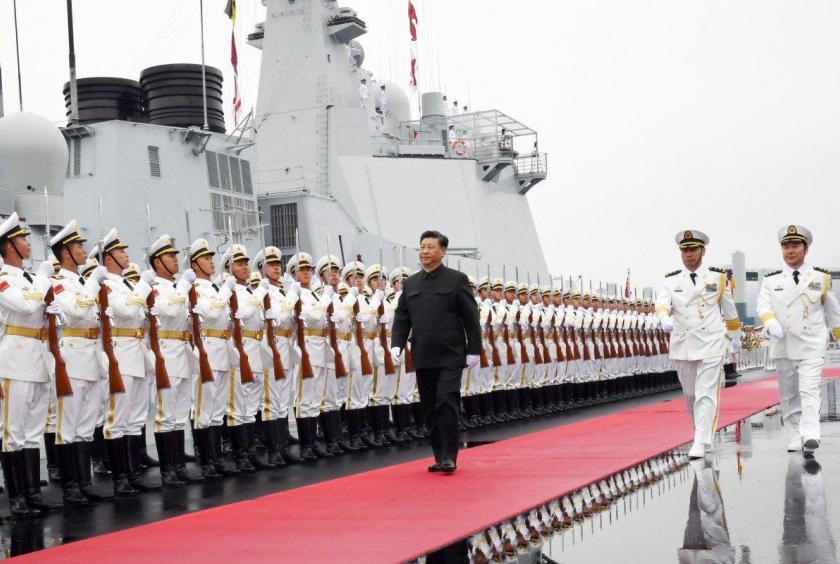(ANN/The Statesman) - China’s presence in the Andaman region is linked to survival and its activism is here to stay. Beijing’s cat-and-mouse moves in the Indian Ocean are still rather unlike the openly belligerent posture of the PLA’s Navy in the restive South China Seas. Though not a full ‘blue-water’ capability Navy as yet, its force projection and assertion are limited to the ASEAN and the Far East. On the Southern front, beyond the South China Sea rim, the Chinese sought to develop geostrategic ports in a strangulating ‘String of Pearls’ pattern that willy-nilly encircled India.
Already, the Chinese have ensnared the Hambantota port in Sri Lanka with its ‘debt-trap’, it is developing the Gwadar port in Pakistan to facilitate the gargantuan China Pakistan Economic Corridor (CPEC), has financed Chittagong port in Bangladesh and has won the rights for the Kyaukpyu port project in Myanmar. All these are ostensibly commercial projects, which offer an invaluable ‘dual’ capability of harbouring Naval / Military might, when required ~ exactly as it did in Djibouti, where the one-time commercial port, now hosts the first international support base for the Chinese military, in the strategic Horn of Africa.
Beyond power projection, the Chinese military footprint in Djibouti is locked cheek-by-jowl with the US, French and Japanese, who have their own military bases in Djibouti to secure the energy and trade seaways. Undoubtedly, the Red Sea around Djibouti was a potential ‘choke-point’, both from the menacing presence of Somali pirates, and more importantly, from the military presence of ‘unfriendly’ powers. Now, the only other similar ‘choke-point’ from a Chinese doomsday perspective is through the ultra-narrow (only 1.5 nautical miles wide at its narrowest point), Malacca Straits. Arguably the busiest seaway in the world with over 1,00,000 vessels transiting annually, it carries 40 per cent of the globally traded goods, and most crucially, accounts for nearly 80 per cent of China’s life-sustaining, crude oil imports.
Worryingly for China, the Malacca Straits opens at the lower tip of the Indian territory of Andaman and Nicobar Islands and its territorial waters, another potential ‘unfriendly’ power. The fact that these waters are not even disputed unlike the South China Seas, where China has brazenly appropriated claim with its unique ‘nine-dashline’ formula that was dismissed by the International Court of Justice, in the case involving territorial counterclaims between, Philippines and China. Yet China ignored the verdict and ‘bought-out’ Philippines acquiescence, against pressing the same claim, anymore. But the Malacca Straits and the Andaman Seas are not within China’s immediate bullying domain, and therefore it needs a more nuanced, sneaky and masked route to register its presence and protect its vulnerabilities.
Murmurs of Chinese naval presence or at least hosting a snooping SIGNIT facility at the Myanmar’s Coco Islands (barely 12 nautical miles from the nearest tip of Indian territory of the Andaman and Nicobar Islands) have been doing the rounds for a long time. While so far, no credible sighting or presence has been established, the threat of Chinese equations with Myanmar’s former junta, who still serve in Myanmar’s influential military, persists. China’s efforts to entrench itself through investing and developing a ‘township’ on the Malaysian side of the Malacca Straits, was undone by the change of government in Kuala Lumpur in 2018. Similarly Chinese plans to set up an observatory near a potential base in one of the Maldivian atolls, may also have serendipitously got a push-back with the change in political dispensation.
Though, a Type O39A Yuan class Chinese submarine was spotted lurking in the Indian Ocean, the fate of Hambantota port with the new Sri Lankan Rajyapaksha Presidency is yet to be decided, though so far the Chinese have maintained that they will abstain from militarising the same. With this backdrop of recent setbacks for the Chinese in establishing a concrete foothold in the Andaman Seas and thereby the uber-sensitive Malacca Straits, the recent comments by the Indian Naval Chief regarding Chinese activism in the Andaman waters warrants serious consideration. The Chief’s comments of the un-notified presence and push-back to a Chinese ‘research’ vessel, Shi Yan 1, is typical of a multihued Chinese tact entailing researchcommercial- military imperatives of any mission.
Chinese presence via oceanographic vessels, antipiracy escort force, deep sea mining vessels et al, are indeed symptomatic of ‘necessities’ that China will stitch together and posit to justify its presence, as it did in Djibouti. Naval investments are about expanded sovereign ambitions, as much as for defensive purposes. India needs to rethink its decreasing budgetary allocations towards the Navy. The militaristic posturing with ‘neighbourhood first’ bonhomie, more strategically and expansively with ‘Quad’ (US, Japan, Australia and India ~ all China wary nations), or through initiatives like the biennial ‘Milan Naval Exercises’ in the Andaman Seas, entailing the jointmanship of 41 Navies pooling their warships is par for course, but not enough.
Like China, India needs to develop its region around the Malacca Straits with a ‘dual’ utility outlook that can have a strong commercial proposition and sustainability lever, given the obvious transshipment and repairing-andrefueling opportunities afforded by the busy seaways. Such a maritime eco-system would necessitate accompanying airstrips that can have a more ‘offensive’ utility, should the need arise. India has the necessary wherewithal in terms of real estate, existing military infrastructure of the Andaman and Nicobar Tri Forces Command, as indeed, the moral legitimacy to develop and protect itself against the proven expansionist agenda of the Chinese. This is the rare strategic jugular against China and the Chinese have feared this for long. India needs to recognise and act accordingly, as the Chinese activism in the region is here to stay.











